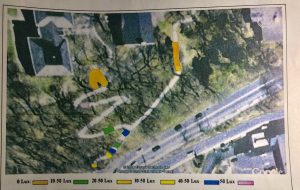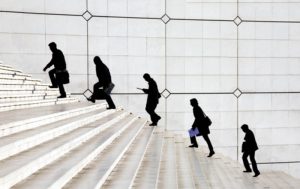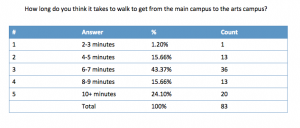Social Context (Stairs)

Introduction
Past projects have defined a problem based off a technical mindset, but with all the projects analysis there still has yet to be a final solution. We believe that the technical deterministic mindset will not provide the best solution for the stairs. Past projects have failed for reasons they could have avoided from the first outline of their project, by correctly identifying the problem. The stairs problem definition fits into the social contexts of the problem where we have found three factors that when grouped together define the overall stair problem that will increase traffic from College Hill to downtown Easton. These factors include an environmental factor, a cultural factor and a psychological factor. Besides the fact that various stakeholders identify the stairs as a problem there are other components that go into the research before any physical work can be done. Defining a problem correctly will fix the overall problem of a project, leaving less money and time wasted.
Environmental/Physical Factors
This factor is the one most people actively complain according to a student survey conducted in November 2016 sent out to the Lafayette College student body. The environmental sectors include the physical aspects that are decreasing traffic on the stairs due in part to a solution based off of physical change. Some safety aspects of the stairs include ice, leaves, poor lighting and the slope/topography of the stairs. Ice and leaves cause potential injuries and are safety hazards when combined with the steep slopes along the stairs. The stairs get little sun, which decreases melting time when ice forms. Due to ice forming on such a steep shady slope, the stairs are closed 30-90 days of winter (Oswald 2006). The lighting on the stairs does not meet the required 50-lux, which is the acceptable level according to the IESNA lighting handbook (Rea, 2000). Anything below 10 lux can cause perceptions of safety to decline rapidly. The poor lighting is due to overgrown trees from lack of maintenance and long distances between existing lampposts. Figure1. indicates lux readings throughout the stairs measured by Oswald’s Independent Study data (2006). The student survey distributed in Fall 2016 shows weather and maintenance being the main issue when factoring in if they are willing to take the stairs or not:
“In the winter / when it rains I have great difficulty getting downtown. The costs of going downtown (mainly time) outweigh the benefits (stores). Instead of going to Gentlemen’s for a haircut, I went to a place that wasn’t as good on the hill because I didn’t have much time” (Student Survey 2016).

The slope and topography of the stairs are another concern the students voiced in the survey. The campus’ elevation changes from a high point on campus of 360 feet at the rear of Skillman Library to a low point of 150 feet along the Bushkill Creek. There is an overall change in elevation of 210 feet across campus, from North to South (Lafayette College Master Plan). “Unfortunately the walk down the stairs are very grueling and difficult because of the angle the slopes are on, which range from 15-21% along the path” and half the students that took the survey wrote out comments about the exhausting upward climb, “walking up that hill is too much” (Student Survey 2016). Wilford-Hunt talked about how the high percentage slopes holds precedent when talking about a future solution, “So, certainly the topography is the big barrier. […] But when you are dealing with the hill it adds another challenge–and going down is easier than going up.” Another safety issue in regards to the physical problem is that the current infrastructure lacks handrails on 60% of the descent, which is strictly against ADA safety requirements, “Handrails shall be at a consistent height above walking surfaces, stair nosings, and ramp surfaces” (ADA 2010). The stairs overall pose a safety risk of falling, especially when there is nothing to grab onto. There is also a lack of aesthetic appeal because there are weeds and overgrown branches that take away from the pleasure the people can take in walking up or down the stairs. Weeds such as poison ivy grow on the stairs and disrupt the path (Figure 2.).

There is a lot of cracking along the stairs and slopes that would need to be fixed for safety reasons in order to increase the traffic. Another safety issue that people have brought up is the lack of security in terms of line of sight, safety cameras and lighting at night. Walking alone at night up those stairs without a clear line of sight, caused by the overgrown tree branches and poor lighting, causes people not to use the stairs at night because they don’t know what is around the corner. Dave Hopkins, Easton PA Director of Public Works, remarked when voicing his opinion about safety and the stairs. “Not being able to see that far in front of you causes a lack of incentive to walk up the stairs at night” (Hopkins 2016). This notion is important for the Lafayette Arts Campus because they hold movie showings past sunset and other talks and art shows at night. This is also important to the town of Easton because they want to increase the amount of business down the hill, including restaurants, which will have people walking at night to get home from dinner. The last technical problem that should be addressed in defining the problem is the lack of maintenance and the difficulty of getting supplies to the area to help out with the technical problems talked about above (weeds, cracks, overgrown branches etc.). This would have to be added into the budget and time schedule for Lafayette Plant Operations. A final note on problem definition defined by a technical fix is that Lafayette is one of hundreds of colleges that made a commitment to drastically reduce their energy consumption and become climate neutral and that includes any new projects, including the stairs. Any solution pertaining to the stairs will have to incorporate the increase in sustainable ratings around campus. Check out the Technical Analysis for solution to this problem definition based off of environmental and physical factors.
Cultural Factors
The next component of focus for the problem definition of the stair project centers on the culture of Easton, including the student body base on top of College Hill. This focus first hits upon the divide between the arts campus and the main campus at Lafayette College. The arts campus stresses sharing art pieces and movie screenings and gives the students a chance to form a community around art. The integration between the two campuses does not happen because the culture at Lafayette dictates such a divide between the two campuses that the ‘arts’ in the liberal arts college is not being well represented to a crowd of students that do not major in arts. The benefit of Lafayette College is that it is a liberal arts campus with engineering and science based courses so the student body gets a diverse selection of classes. By increasing traffic across the stairs a broader education between the campuses can be reached. A Lafayette College student, Marissa Rossi, speaks about her personal experience:
“I am a biology major and I am involved in a lot around campus and I have meetings in Ramer History Hall and Oeschle, and though I don’t take classes in history or psychology I am able to interact with the buildings and see what flyers are up and what is going on in their departments. Since none of my meetings or any activities I am involved in go on around the arts campus I have zero knowledge of what they are up to. There is such a divide and I wish that wasn’t the case because I would love to be more involved with that brand new beautiful part of campus.”
There is not only a divide between the arts campus and main campus, there is also a divide between the Lafayette community and the Easton community. Every year there is a community dinner hosted by POSP, a Pre-Orientation Service Program, through Lafayette College that honors a community member. Mayor Sal Panto Jr. annually attends and gives a speech to the 40 first year Lafayette students that participate. He always mentions to the students that this is their home for four years–that Lafayette is not it’s own community, and that Easton is now your community too. He urges the Lafayette students to embrace Easton as their own. This is a problem that he feels is relevant to address to the student body base for the he feels a divide. With the future fix of the stairs an Easton resident states,
“Hopefully the fix works both ways: with students spending money in the city more often and residents of Easton attending more sporting events/open lectures/live arts performances.” (Lehigh Valley Live).
Health is a subcategory in relation to the culture of a town and we want Easton to have a high health rate, as First Lady Michelle Obama pushes for better health across America. America is pushing for healthier lifestyle as obesity levels are still on the rise. Consequently, doctors and health policymakers are working on creating a country that will take the steps instead of riding an elevator or escalator. The steps may be a ‘cardiovascular challenge’, but doctors and health authorities are constantly encouraging people to do more active workouts to promote health, hopefully decreasing the obesity levels. Dr. Bryant from a New York Times article asserts that walking up stairs at a moderate intensity should burn 5 calories a minute for a 120-pound person, 7 for a 150-pound person, and 9 for a 180-pound person (Robins 2009). The fix of the stairs will increase traffic and by increasing traffic more people will burn calories and be healthier than if they drove up the hill.

Easton’s culture is centered around being a ‘walkable’ city. The existence of the Karl Stirner Arts Trail is just an extension of the broader vision of having Easton being a ‘walkable’ city. Dave Hopkins talked about Easton’s plan for creating a “High Line” experience on the old train tracks crossing the Delaware River. The High Line is a 1.45-mile-long New York City linear park built in Manhattan on an elevated section of a disused New York Central Railroad spur called the West Side Line that incorporates artwork and landscaping to create a tourist attraction (Stern and Stern 2011). The idea of expanding spots to incorporate more landmarks only adds to the appeal that Easton brings forth for its residents and tourists. The city is not a high tech city like Singapore, it does not have a futuristic vibe and that means creating a stair way rather than a straightforward technical fix of an elevator or funicular. The Parks and Recreation department of Easton are working on a campaign to have more hills, increase access points surrounding the city and have more fitness activities (Baptiste and Kelly 2016).
Future aspects to consider that show that the stair project needs to be pushed farther into consideration is that the entire Lafayette communications division will go down there, including the back of the house operations unit for admissions, and the center for community engagement. This amounts to about 85 people going downtown that need to have easier travel interaction with the main campus. Another aspect of the culture of the city is that the Spot is to be converted into a college pub, which will increase traffic from main campus to arts campus for more social gain rather than academic, which will bring a different focused crowd to the Arts Campus more often (Wilford-Hunt, Personal Communication, 2016).
Psychological Factors
The final problem definition to consider is the psychological component that a lot of people neglect to integrate into the system of problem definition. The stairs are not in fashion at Lafayette College. At Indiana University it can take up to 30 minutes for a student to walk from class to class. The students do not have other options so that is set in their mind to just do it. At Arizona State University a lot of people ride their bike to class, that is their student’s mindset. There are different perceptions of what it is like to travel around campus. At Lafayette College a sense of a ‘small’ college has turned into a very lazy campus when it comes to commute time, for many people do not like taking more than 10 minutes to travel anywhere, for that is the change time given by the college in between classes. This is the perception that the student body at Lafayette College has. The perception also includes that the stairs are not user friendly so just do not use them. One time going up and down them and people write them off. Livestrong hiking data suggests that for the average person the downhill time for the main path, being 1/7 mile, should take 4.28 minutes going up and 3.46 minutes going down. Oswald’s Independent Study in 2006 suggested even faster times at 2:45 minutes to walk down and 3:30 minutes to walk up (Oswald 2006). From a student survey taken at Lafayette College out of 90 students, only 14 of those students correctly identified the correct times (Figure 3.)

When Lafayette wants to get students to go to events, they market the event, they send emails and they outwardly encourage the students to attend. There has been no marketing of the stairs, only perceived hate from upperclassman being passed down from generation to generation over the years. The stairs need to be integrated into Lafayette the same way the stairs down to the Kirby gym are. If people want to go to sporting events or work out they use those stairs, despite the climb being around the same distance as the stairs down to the Arts Campus. People use the gym every day, making it engrained in their minds that they have to use the stairs. From an early integration of the stairs from orientation to a continued integration through First Year Seminars, to having clubs use them, to the point of making people walk to their LANDIS community work by using them, people will be less afraid of them. The psychological barrier can be broken if it becomes just as much of the culture of Lafayette as the hate from the 152 years of rivalry against Lehigh.
Conclusion
Society has a tendency to move towards a technological fix. This is apparent in the interest in the elevator from many students and Easton community members. Engineering a physical solution is only one component of a fix. There needs to be more than the technological aspect, the cultural and psychological problem definitions also need to be taken into account. A lot of engineering projects fail because the team does not take the time to learn what the problem is and to create a fix that manages to address the root causes. Sometimes seeing a physical change makes people feel like they have fixed a problem because something new to the their line of sight has been developed. Looking at different problem definitions is key to a project that involves a copious amount of people because you are not just talking to one owner. In this problem definition we are not pleasing one sole owner, we have to please the masses. By knowing the environmental, cultural and psychological problems the political, technical and economic solutions will be able to settle on the best solution for the Lafayette Stairs.
